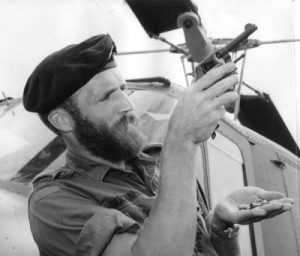- Author
- A.N. Other
- Subjects
- Naval Aviation, Post WWII
- Tags
-
- RAN Ships
- None noted.
- Publication
- March 2012 edition of the Naval Historical Review (all rights reserved)

LEUT Buchanan recalled the intensity of his first sortie: ‘on the return flight which was made at dusk, then in darkness, it seemed that we took fire from every tree line we crossed.’ Such conditions would continue throughout his deployment, undoubtedly testing his mettle each sortie he flew. In the early morning of 3 December 1970, Viet Cong attacked the 9th AVRN outpost in Vinh Binh Province. By the time an EMU fire support party arrival the South Vietnamese had been overrun.
Early the next day as South Vietnamese soldiers were MEDEVACED onto a patrol boat in the U Minh River Delta, they came under heavy fire. The boat sustained significant damage and began drifting toward the shore where enemy forces were positioned. Fifty meters away, the supporting patrol boat received a direct hit from by a B-40 rocket, exploding. Facing heavy automatic weapons and mortar fire, LEUT Buchanan persisted with the MEDEVAC operation, attempting to withdraw the injured South Vietnamese soldiers from the patrol boat onto his Huey. Realising that the stricken patrol boat crew were effectively trapped, LEUT Buchanan then proceeded to manoeuvre the vessel with his helicopter, an incredible example of his flying talent.
‘LEUT Buchanan hooked the skids of his aircraft onto the boat’s superstructure and towed it to a safe area although he was still receiving heavy automatic weapons and 82 millimetre mortar fire.’ After flying for almost fourteen continuous hours under imposing conditions LEUT Buchanan demonstrated momentous courage and initiative. ‘For his coolness, determination and courage under fire’ he was awarded the Australian Distinguished Flying Cross.[8]
RANHFV and the RAN Fleet Air Arm
Although relatively unknown to the Australian public and military community, the pilots, observers, aircrew and technicians of the RANHFV embodied the values of the RAN, showing great courage and commitment in their duty. Such commitment is emphasised by the US Captain Jerry Johnson’s comment that ‘some of the crewman would fly all day and then work on their helicopters all night so we could get them up. Some of them even slept in the helicopters.’[9]
The tenacity of the EMU’s is summed up in a congratulatory signal sent by a commander of ground troops, which praised the unit’s ability to ‘get the bloody job done.’ This quote was to be adopted as the unit’s unofficial motto.
Members of RANHFV, such as SBLT Perry and LEUT Buchanan, demonstrated the unique qualities of Australian’s in conflict. Under high intensity combat, very testing environmental conditions and unique interoperable circumstances the men of RANHFV served with heroic distinction and maintained a high degree of professional competency. Furthermore, the RANHFV managed to preserve a certain ‘Aussie larrikin’ individuality as they seriously practised the business of ‘getting the bloody job done’—risks were certainly taken but the end aim was to get the job done and if the rule book had to go out of the window, such was life. These are the qualities that set the example for members of the Fleet Air Arm today.
Reflection
The two accounts documented above provide an illustrious example to aspiring RAN aviators, the whole Australian Defence Force and indeed the wider Australian community. It is important to note that many members of the RANHFV were nominated for foreign awards but under rules in place at that time were unable to receive them. Similarly, the actions and stories of the RANHFV have unfortunately fallen victim to the political unpopularity of the Vietnam War and have been somewhat lost over time. Perhaps this short essay is a timely reminder of the need for further detailed research into the exploits of the RANHFV.
Editorial Note
For reasons of space, the bibliography and many endnotes have been omitted. The full text of this essay is available upon request to the Naval Historical Society.
[1] M. Speedy & B. Ray, A Bloody Job Well Done: The History of the Royal Australian Navy Helicopter Flight Vietnam, Camprint Communications, Canberra Act, 2008, p. 201.
[2] M. Speedy & B. Ray, p. 152-154.
[3] P. Ham, Vietnam: the Australian War, Harper Collins, Sydney, 2007, p.398.
[4] M. Speedy & B. Ray, p. 178.
[5] M. Speedy & B. Ray, p. ii.




